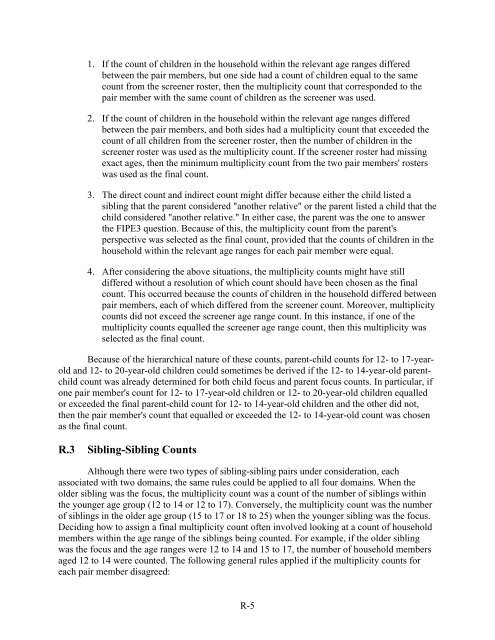Questionnaire Dwelling Unit-Level and Person Pair-Level Sampling ...
Questionnaire Dwelling Unit-Level and Person Pair-Level Sampling ...
Questionnaire Dwelling Unit-Level and Person Pair-Level Sampling ...
You also want an ePaper? Increase the reach of your titles
YUMPU automatically turns print PDFs into web optimized ePapers that Google loves.
1. If the count of children in the household within the relevant age ranges differed<br />
between the pair members, but one side had a count of children equal to the same<br />
count from the screener roster, then the multiplicity count that corresponded to the<br />
pair member with the same count of children as the screener was used.<br />
2. If the count of children in the household within the relevant age ranges differed<br />
between the pair members, <strong>and</strong> both sides had a multiplicity count that exceeded the<br />
count of all children from the screener roster, then the number of children in the<br />
screener roster was used as the multiplicity count. If the screener roster had missing<br />
exact ages, then the minimum multiplicity count from the two pair members' rosters<br />
was used as the final count.<br />
3. The direct count <strong>and</strong> indirect count might differ because either the child listed a<br />
sibling that the parent considered "another relative" or the parent listed a child that the<br />
child considered "another relative." In either case, the parent was the one to answer<br />
the FIPE3 question. Because of this, the multiplicity count from the parent's<br />
perspective was selected as the final count, provided that the counts of children in the<br />
household within the relevant age ranges for each pair member were equal.<br />
4. After considering the above situations, the multiplicity counts might have still<br />
differed without a resolution of which count should have been chosen as the final<br />
count. This occurred because the counts of children in the household differed between<br />
pair members, each of which differed from the screener count. Moreover, multiplicity<br />
counts did not exceed the screener age range count. In this instance, if one of the<br />
multiplicity counts equalled the screener age range count, then this multiplicity was<br />
selected as the final count.<br />
Because of the hierarchical nature of these counts, parent-child counts for 12- to 17-yearold<br />
<strong>and</strong> 12- to 20-year-old children could sometimes be derived if the 12- to 14-year-old parentchild<br />
count was already determined for both child focus <strong>and</strong> parent focus counts. In particular, if<br />
one pair member's count for 12- to 17-year-old children or 12- to 20-year-old children equalled<br />
or exceeded the final parent-child count for 12- to 14-year-old children <strong>and</strong> the other did not,<br />
then the pair member's count that equalled or exceeded the 12- to 14-year-old count was chosen<br />
as the final count.<br />
R.3 Sibling-Sibling Counts<br />
Although there were two types of sibling-sibling pairs under consideration, each<br />
associated with two domains, the same rules could be applied to all four domains. When the<br />
older sibling was the focus, the multiplicity count was a count of the number of siblings within<br />
the younger age group (12 to 14 or 12 to 17). Conversely, the multiplicity count was the number<br />
of siblings in the older age group (15 to 17 or 18 to 25) when the younger sibling was the focus.<br />
Deciding how to assign a final multiplicity count often involved looking at a count of household<br />
members within the age range of the siblings being counted. For example, if the older sibling<br />
was the focus <strong>and</strong> the age ranges were 12 to 14 <strong>and</strong> 15 to 17, the number of household members<br />
aged 12 to 14 were counted. The following general rules applied if the multiplicity counts for<br />
each pair member disagreed:<br />
R-5
















